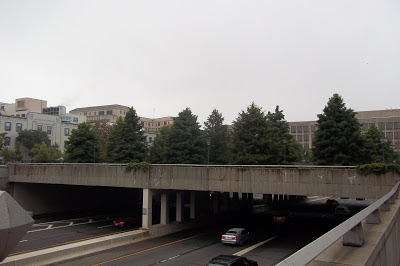Friday, October 12, 2012
CAM experiments at UGA
I am excited to report the results of our ongoing study taking place in UGa's (Marc van Iersel's) specialized experimental chambers for measuring CO2 exchange. We are studying two commonly used greenroof plant species, Sedum album, and Sedum kamtschaticum. These species are CAM cyclers which means they carry out C3 (CO2 exchange positive during the day, negative at night) photosynthesis when well watered and switch to CAM (CO2 exchange neutral during the day, positive at night)photosynthesis in response to drought
In our experiment, we began with well watered plants and monitored CO2 exchange as substrate moisture content declined. In the enclosed graphs, you can see how the two species (Sedum album in red above and Sedum kamtschaticum in green below) gradually reduce CO2 exchange during the day and increase exchange at night over the course of the experiment. We think this is pretty exciting because the patterns observed fit some classic predictions found in the literature. It's also interesting that the two different species seem to have different photosynthetic responses to drought.Future work will involve analyzing the photosynthetic response in more detail (calculating other parameters such as daily carbon gain, correcting for differences in initial plant biomass, etc) and combining this information with detailed data we are collecting on substrate moisture content.
urban swamp
Post conference touring
UMD greenroof conference
Also, in August, we were able to host a bunch of greenroof researchers and professionals here in MD at our first Greenroof Science and Technology Symposium:
Data! and ESA in Portland
Seattle
After Pullman, it was off to Seattle for some personal time and some meeting with some stormwater professionals. I also got to hang out with our lab tech, Bruk, at the market.
The best part was the tour of the underground city! You can see the old water conveyance system made of wood. I'm also including a view of the glass sidewalk tiles from below.
The best part was the tour of the underground city! You can see the old water conveyance system made of wood. I'm also including a view of the glass sidewalk tiles from below.
Decagon and Pullman
Getting caught up after a summer of meetings and travel.
First, back in July, I attended an SCRI project meeting in Pullman, WA and got to tour around the Decagon Devices facility. Hopefully, there will be more pics of this, but for now, here's a pic of the building:
First, back in July, I attended an SCRI project meeting in Pullman, WA and got to tour around the Decagon Devices facility. Hopefully, there will be more pics of this, but for now, here's a pic of the building:
Subscribe to:
Posts (Atom)















